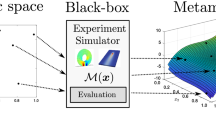Abstract
When drawing a contour map from a set of irregularly spaced data points, two methods are often used: The first corresponds to a rather aesthetic criterion and consists of obtaining contour lines which will be as “smooth”as possible and will honor the data points. This generally is the objective of the draftsman, and it can be automatically performed by the method of spline interpolation. The other method, used in kriging, is to compute the Best Linear Unbiased Estimator (B.L.U.E.),that is, to obtain a map as accurate as possible. Is it possible, in practice, to predict whether the aesthetic map will also be accurate? In this paper, we first examine the theoretical point of view: Spline interpolation is equivalent to kriging with a given (generalized)covariance. We then take an example to show how this question can be answered in practice: by testing how well the spline covariance is suited to the data.
Similar content being viewed by others
References
Ahlberg, Nilson, and Walsh, The theory of splines and its applications, Academic Press, New York, 280 p.
Chilès, J. P., 1977, Géostatistique des phénomènes non stationnaires (dans le plan), “Docteur-Ingénieur” thesis: Centre de Géostatistique, Ecole des Mines de Paris, Fontainebleau, 152 p.
Delfiner, P., 1975, Linear estimation of non-stationary spatial phenomena, Proceedings of NATO-ASI advanced geostatistics in the mining industry, Rome, 1975: D. Reidel Publishing Co., Dordrecht, Holland, p. 49–68.
Dubrule, O., 1981a, Comparing “Plaque mince” splines and kriging, Internal Report, Centre de Géostatistique: Ecole des Mines de Paris, Fontainebleau, 24 p. (to be published in “Computers and Geosciences).
Dubrule, O., 1981b, Krigeage et splines en cartographie automatique—application à des exemples pétroliers. “Docteur-Ingénieur” thesis; Centre de Géostatistique, Ecole des Mines de Paris, Fontainebleau. 141 p.
Laurent, P. J., 1972, Approximation et optimisation: Enseignement des Sciences, Hermann, Paris, 531 p.
Matheron, G., 1973, The intrinsic random functions and their applications: Adv. Appl. prob.; v. 5, p. 439–468.
Matheron, G., 1980, Splines and kriging: Their formal equivalence, Internal Report, Centre de Géostatistique: Ecole des Mines de Paris, Fontainebleau. 20 p.
Utreras, F., 1979, Utilisation de la méthode de validation croisée pour le lissage par fonctions splines à une ou deux variables, “Docteur-Ingénieur” thesis: Université Scientifique et Médicale de Grenoble, 192 p.
Wahba, G., 1979, How to smooth curves and surfaces with splines and cross-validation, Proceedings, 24th Design of experiments conference, F. Dressel (Ed.): New York, Academic Press, 25 p.
Author information
Authors and Affiliations
Rights and permissions
About this article
Cite this article
Dubrule, O. Two methods with different objectives: Splines and kriging. Mathematical Geology 15, 245–257 (1983). https://doi.org/10.1007/BF01036069
Received:
Revised:
Issue Date:
DOI: https://doi.org/10.1007/BF01036069




